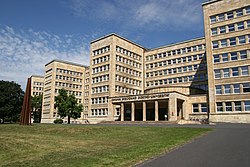
Back Budova I.G. Farben Czech I.G. Farben-Gebäude German Κτήριο της IG Farben Greek Edificio IG Farben Spanish IG Farben -rakennus Finnish Bâtiment de l'IG Farben French בניין אי גה פארבן HE Gedung IG Farben ID I.G.-Farben-Haus Italian Bangunan IG Farben Malay
| I.G. Farben Building | |
|---|---|
 Main front | |
 | |
| General information | |
| Year(s) built | 1928-1930 |
| Owner | Goethe University |
| Website | |
| IG Farben Building | |
The I.G. Farben Building – also known as the Poelzig Building and the Abrams Building, formerly informally called The Pentagon of Europe – is a building complex in Frankfurt, Germany, which currently serves as the main structure of the Westend Campus of the University of Frankfurt. Construction began in 1928 and was complete in 1930[1] as the corporate headquarters of the I.G. Farben conglomerate, then the world's largest chemical company and the world's fourth-largest company overall.[2]
The building's original design in the modernist New Objectivity style was the subject of a competition which was eventually won by the architect Hans Poelzig. On its completion, the complex was the largest office building in Europe and remained so until the 1950s.[3] The I.G. Farben Building's six square wings retain a modern, spare elegance, despite its mammoth size. It is also notable for its paternoster elevators.[4]
The building was the headquarters for production administration of dyes, pharmaceutical drugs, magnesium, lubricating oil, explosives, and methanol, and for research projects relating to the development of synthetic oil and rubber during World War II. Notably I.G. Farben scientists discovered the first antibiotic, fundamentally reformed medical research and "opened a new era in medicine."[5] After World War II, the IG Farben Building served as the headquarters for the Supreme Allied Command and from 1949 to 1952 the High Commissioner for Germany (HICOG). William L. Shirer called it the "building from where the Americans ruled the western part of Germany" in the aftermath of World War II.[6] Notably Dwight D. Eisenhower had his office in the building. It became the principal location for implementing the Marshall Plan, which supported the post-war reconstruction of Europe. The 1948 Frankfurt Documents, which led to the creation of a West German state allied with the western powers, were signed in the building.[7] The I.G. Farben Building served as the headquarters for the US Army's V Corps and the Northern Area Command (NACOM) until 1995. It was also the headquarters of the CIA in Germany. During the early Cold War, it was referred to by US authorities as the Headquarters Building, United States Army Europe (USAREUR); the US Army renamed the building the General Creighton W. Abrams Building in 1975.[1] It was informally referred to as "The Pentagon of Europe."[8]
In 1995, the US Army transferred the IG Farben Building to the German government, and it was purchased by the state of Hesse on behalf of the University of Frankfurt. Renamed the Poelzig Building in honour of its architect, the building underwent a restoration and was opened as part of the university in 2001. It is the central building of the Westend Campus of the university, which also includes over a dozen other buildings built after 2001.
- ^ a b Linke, Vera (2002-03-02). Das I.G. Farbenhaus – Ein Bau der, deutsche Geschichte widerspiegelt (The IG Farben Building – A building that reflects German History) (in German). Hausarbeiten.de. ISBN 978-3-640-04757-4. Archived from the original on 2008-02-24. Retrieved 2006-06-06.
- ^ "I.G. Farben I.G. Farbenindustrie AG German Industry and the Holocaust". Holocaust Research Project. Archived from the original on 2020-08-30. Retrieved 2020-09-21.
- ^ "IG Farben-Haus, Geschichte und Gegenwart (IG Farben Building, History and Present)" (in German). Fritz Bauer institute. Archived from the original on 2007-03-14. Retrieved 2006-07-18.
- ^ Johnson, Dirk (Summer 2005). "Modern Languages: Professor Johnson Continues Research in Germany". Hampden-Sydney College. Archived from the original on 2006-09-01.
- ^ Thomas Hager, The Demon under the Microscope, Harmony Books, 2006, ISBN 1-4000-8214-5
- ^ William L. Shirer, Midcentury Journey: The Western World through Its Years of Conflict (New York: Farrar, Straus and Young, 1952), p. 113.
- ^ Rundschau, Frankfurter (30 June 2008). "IG-Farben-Haus 1948: Der Weg in die Republik". Frankfurter Rundschau. Archived from the original on 21 February 2018. Retrieved 27 June 2017.
- ^ Frankfurt Humanities Research Centre. "The IG Farben Building 1945–1995". www.muk.uni-frankfurt.de. Goethe-Universität. Archived from the original on 2020-09-23. Retrieved 2018-01-05.